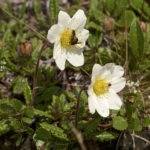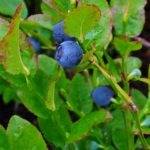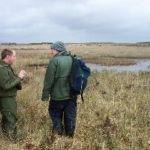Ireland has a comparatively small flora for a European country.
Partly this is due to the fact that it is not a large country, and geologically not very varied, but a major factor is that ice-sheets covered much of Ireland until 13,000 years ago. The majority of our flora and fauna has only returned as the ice sheets retreated. By 10,000 years ago the climate had warmed up, and a land-bridge may have connected Wales and the east coast of Ireland – the sea levels being over 250 foot lower than they are today, since the water was frozen into the vast ice caps covering the rest of northern Asia and North America. Plants and animals were able to cross this land-bridge until about 7,500 years ago, when it was finally covered by the rising sea level.
Navigate this page with the section menu to the right, or simply scroll down.
David Webb’s 1984 paper, ‘The Flora of Ireland in its European Context’ (Journal of Life Sciences) provides an excellent summation of how Ireland’s flora relates to, and differs from, other European Floras. You may also enjoy browsing resources for the study of the Irish Flora.
Vegetation of Ireland
Ireland owes its designation as the Emerald Isle to its mild winters and damp summers, which result in a year-round greenness. Despite the small area of woodland in the country many plants, which on the continent and even in Britain, are regarded as characteristic of woodland, are abundant in open country. This is especially so as one travels towards the west coast.
Characteristic plant communities of a more or less specialised type may be found in salt-marshes, sand-dunes, cliffs or lake-shores, limestone pavement, and mountain locations. One of Ireland’s most famous botanical sites is the Burren in County Clare. Among the extraordinary features of this area, botanically, is the combination of alpine plants (e.g. Dryas octopetala) growing side by side with Mediterranean species (e.g. Neotinea maculata). This is explained by the unique combination of cool, wet summers, which enables the alpines, which cannot tolerate summer drought, to survive; and the mild winters, which allow the frost-sensitive Mediterranean species to survive.
Between them, these particular habitats represent a small fraction of the total area of Ireland. Today the bulk of Ireland’s semi-natural vegetation is made up of three major habitats: Grassland, Heath and Bog.
Grassland and Forest
Without agricultural clearance and the presence of grazing animals, small trees and shrubs invade grassland and turn it into scrub. Over time (50 to 100 years) this scrub turns into forest, and the kinds of trees present will depend upon the site. On limestone rock or soils, hazel, coll (Corylus avellana) scrub will develop, and gradually be replaced by ash, fuinseog (Fraxinus exselsior) forest. Thin, acidic soils on the other hand, will develop into woodland of sessile oak, dair ghaelach (Quercus petraea), while deeper richer soils would give rise to forest dominated by pedunculate oak, dair ghallda (Quercus robur). In each case many of the same species of tree occur, but the dominance of one or two particular species usually gives the wood its characteristic appearance. Ireland today is one of the least forested lands in Europe.
Heath
Heath is a transitional community, which links the more upland types of grassland with the drier types of mountain blanket bog. It occurs on shallow, peaty soils, with a higher mineral content than true peat characteristic of bogs. This community usually comprises a patchwork, with different areas dominated by different species; bracken, raithneach mhór (Pteridium aquilinum), bilberry, fraochán (Vaccinium myrtillus), bell heather, fraoch cloigíneach (Erica cinerea), ling heather, fraoch mór (Calluna vulgaris), rushes, sedges or grasses.
Bog or Peatland
There are three major types of bog in Ireland: fens (which form where the bog is fed from ground waters rich in nutrients), raised bogs (which occupy the sites of former lake basins, and often form on top of fens, especially in the Irish midlands), and blanket bogs (which cover mountain tops or sloping ground, especially on the west coast).
Fens are bogs which form in lake basins. The community of grasses, sedges, and bryophytes is fed from ground waters rich in nutrients. They are very often an early stage in the formation of raised bogs which grow on top of the fen. Their depth can vary depending on their location but they are usually 2m to 3m in depth. Fens are amongst the most threatened habitats in Ireland, being small and easily damaged. Some of our rarest flowering plants and bryophytes are confined to fens.
Raised bog is almost pure sphagnum moss (susán) with scattered grasses and sedges, and these are the bogs from which moss peat is extracted. Sphagnum can grow on rainwater alone, and as long as grasses, sedges, and heathers cannot obtain sufficient nutrients from the bog, the sphagnum will continue to outstrip them in speed of growth, forming a huge dome of moss that gradually spreads outwards from the original lake basin from where it starts. Raised bogs probably began growing about 7,000 years ago. About a foot below the surface of a bog the water is deprived of all oxygen, and the dead remains of moss, other plants and even humans can be preserved indefinitely. Country dwellers used to store butter below the surface of bogs, and examples of ‘bog-butter’ are still occasionally found. Raised bogs are fragile because they are like a huge plastic bag full of water – as soon as you make a pin prick in them they drain away and collapse. These bogs are sometimes called red bogs, because the dry peat looks brownish-red in colour; in blanket bog the cut sods dry black.
Blanket bogs cover much of the hills and land along the west coast of Ireland. They are dominated by heathers, grasses, and sedges as well as sphagnum moss. Blanket bogs only develop in areas of the west, or mountaintops with particularly high rainfall (more than 1.3 metres per year). They began growing about 4,000 years ago when rainfall increased. On higher ground, bogs are often referred to as moorland, where they are somewhat transitional between heath (dominated by heathers) and bog (dominated by sphagnum moss). These bogs are a lot less sensitive to being cut, and continue to grow after harvesting. Below these bogs and raised bogs can be found the remains of forest trees that once dominated the Irish landscape. At Shanvallycahill, on the shores of Lough Mask, there is an amazing forest of pine stumps sitting on the original soil surface of 4,500 years ago. The blanket bog has been harvested for turf, which is used for heating. These trees died where they stood as the moss suffocated their roots.











